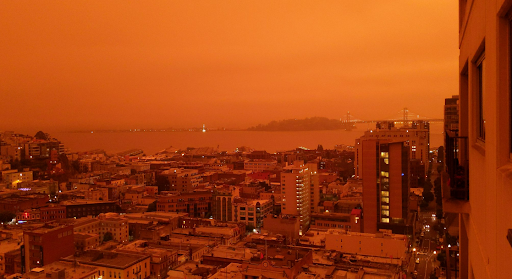Apocalypse now

Entire towns razed by fire, cities choked with smoke, evacuation orders creeping closer. Scenes from the west coast of the United States will be familiar to most people in Australia. The images are reminiscent of those here during the last bushfire season: apocalyptic, dystopian and unsettling; a reminder of what is still to come and a call to action for us all.
Wildfires in California have already set a new annual record for the total area burned, topping the fires of 2018. Oregon is experiencing the worst air quality on record while 40,000 residents have been forced to evacuate and 500,000, roughly 10 percent of the state’s population, have been told to prepare for evacuation. There’s a record for the total area burned in Washington state as well, surpassing the wildfire season of 2015.
All this is unprecedented, but we can’t say it is surprising. Across regions of the world as wide apart as Australia, the Amazon and the Arctic, the weather conditions that make wildfires more likely and more severe are being exacerbated by climate change. Fires this year have spread across Africa and South America, putting millions of people in immediate danger of death and immiseration. Governments and businesses across the globe are not doing enough to curtail carbon emissions and mitigate the risks. Investments in renewable energy, and long-term disaster prevention and response, are still subordinated to economic gains.
After running on a message of “hope and change” to victory in the 2008 US presidential election, Barack Obama bragged about the 88 percent growth of the oil and gas industry during his two terms in office. “Suddenly America is the largest oil producer, that was me people ... say thank you”, he told an audience at Rice University in Texas in 2018. His administration signed new environmental regulations into law, but these were constantly designed to accommodate US businesses’ need to increase profits.
Many of those already weak environmental regulations have been rolled back entirely under Trump. The head of the ticket opposing Trump in this year’s US presidential election, former Vice President Joe Biden, has offered a set of milquetoast goals for climate action, including the promise of net-zero emissions by 2050—far too late to prevent the increasing frequency of natural disasters due to climate change. He has stressed repeatedly that his platform does not include a stop to hydraulic fracturing, or fracking, which is the main driver of the growth in the US domestic oil and gas industry and a major source of methane emissions.
In Oregon, members of the far right, already up in arms about Black Lives Matter protests in the state’s largest city, are latching onto rumours that antifa bogeymen are responsible for setting fires around rural towns. They have used this excuse to set up road blocks, receiving mixed messages from local law enforcement. The president himself, unsurprisingly, helped advance these unfounded rumours.
Such conspiracy theories are reminiscent of the political reaction to the bushfire crisis in Australia, when prominent conservatives claimed that “greenies” were setting fires to advance the cause of climate action. So just as extreme fire events are spreading around the world, so too is the extreme-right politics that is committed to stopping any action on climate change and to obscuring the causes of the mass destruction.
The upcoming bushfire season in Australia is not expected to be as severe, partly because so much of the fuel was burned in the last one. But we must take drastic action to prepare for the next wave of megafires as the fire season spreads further beyond the summer months. It won’t be enough to simply leave it to the politicians, the billionaires and the capitalist states in constant competition.
We need a system of international cooperation and democratic decision-making at every level of industrial production, resource distribution, disaster preparedness and response. Capitalism doesn’t offer that possibility, so it’s time to start thinking bigger.